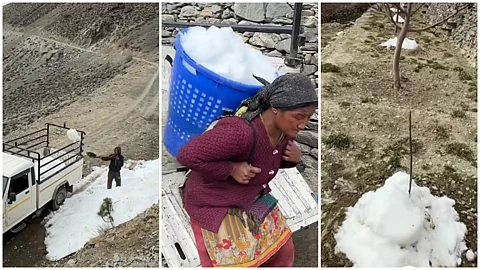

Amid a plunge in snowfall in Himachal Pradesh, farmers in Kinnaur district have now resorted to transporting snow from upper heights to ensure the survival of their apple plantations.
These cultivators bring snow in pick up trucks and lorries and spread it at the stem of the apple plant. This desperate bid by cultivators somehow ensures that the apple plant retains the moisture it needs to attain fruition.
Apple cultivators in the Ropa Valley of Kinnaur, situated in close proximity with the India-Tibet border are aghast at steep reduction in snowfall in this season. It’s a precarious situation and hundreds of farmers are staring at the prospect of a loss-making low yield.
Suresh Borish, an orchardist from Ropa Valley, told Down to Earth (DTE) that over the past two decades, there have been significant changes in the weather patterns in his region.
“Due to the lack of irrigation facilities, the farmers are entirely reliant on rainfall and snowfall. However, with the decrease in snowfall, they are now facing challenges in maintaining moisture in the plants. He explained that the snow that falls now only lasts for two or three days, whereas the apple plants require moisture for a longer period,” Borish said.
“To address this, the farmers gather snow from areas that are less exposed to direct sunlight. At such locations, the snow stays frozen for longer durations and are situated as far as five kilometres from the orchard. We bring the snow in mini-trucks and place it around the trunks of the apple plants. This helps maintain moisture for a longer time, increasing the survival rate of the plants. Without this, newly planted trees are at risk of severe damage due to dryness,” the cultivator explained further.
Kishore Sharma, assistant professor in the Department of Plant Pathology at Dr YS Parmar University of Horticulture and Forestry, told DTE that maintaining moisture in plants is a major challenge for farmers this year due to the dry conditions. He noted that the drought could reduce yields by as much as 30 per cent. Moreover, if these conditions persist, there is a risk of increased plant diseases in the future.
Borish mentioned that the traditional ‘royal’ variety of Apple, which was once abundant in the region, has now receded to higher altitudes.
“Farmers in the area are now planting varieties like ‘spur’ to adapt to the changing climate and ensure better yields,” the farmer shared.
According to the India Meteorological Department, rainfall in Himachal Pradesh was 41 per cent below average between October and December. Additionally, from January 1 to February 13, there was a 77 per cent reduction in rainfall. In Kinnaur district, rainfall was 41 per cent lower between October and December, and 90 per cent lower between January and February. Additionally, February has seen 84 per cent less rainfall than usual.
This year, early flowering has been observed in fruits and rhododendron plants in Himachal Pradesh. Experts believe that if these conditions continue, the fruit and crop yields may suffer significant losses endangering food security.
For complete analysis, subscribe to the 1-15 March 2025 edition of Down To Earth